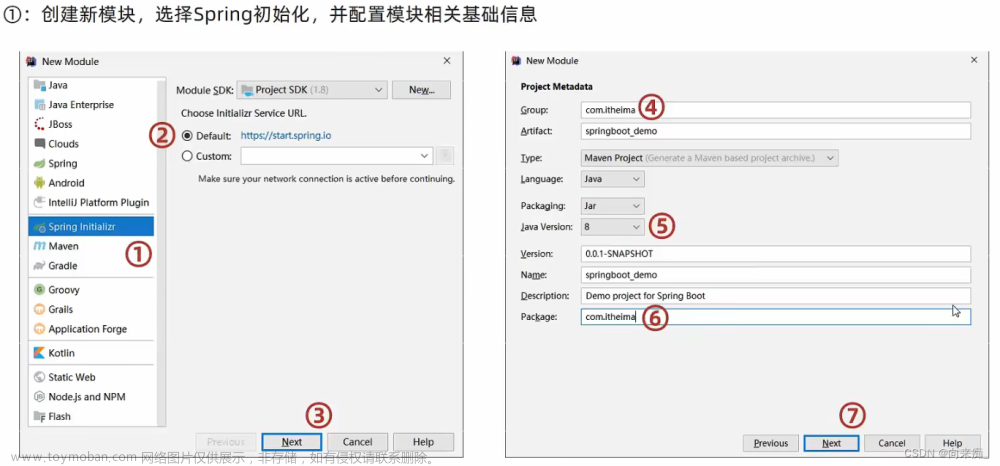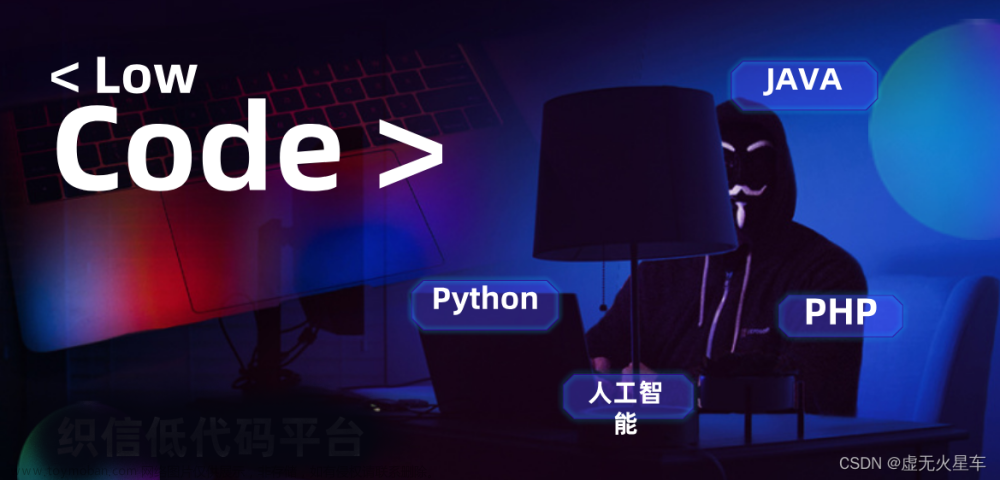Disable verbose logging
log4j.logger.org.apache.shiro.util.ThreadContext=WARN
log4j.logger.org.apache.shiro.cache.ehcache.EhCache=WARN
shiro.ini,需要安装ini插件
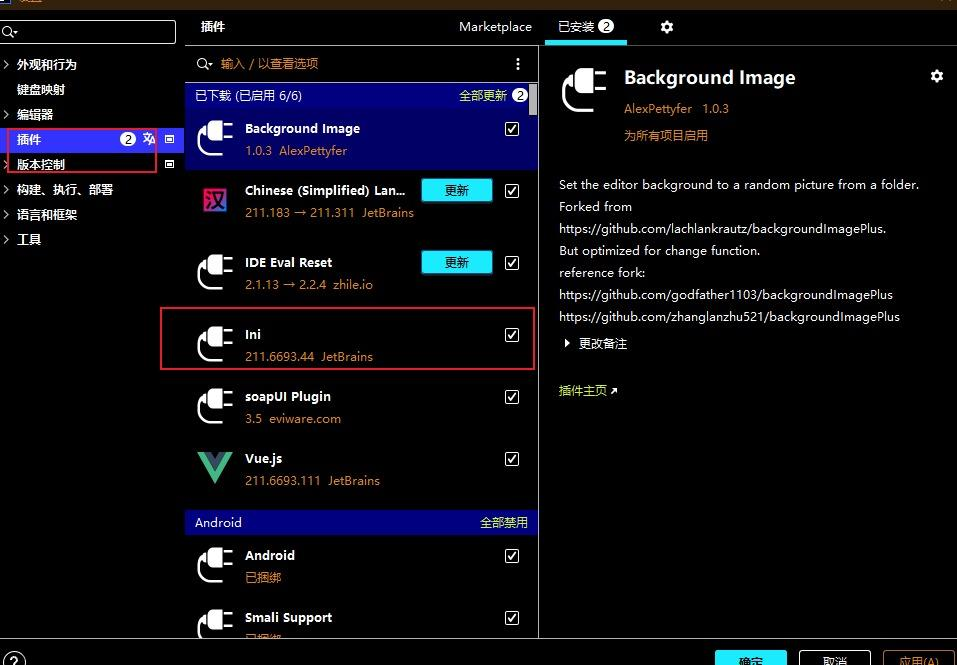
[users]
user ‘root’ with password ‘secret’ and the ‘admin’ role
root = secret, admin
user ‘guest’ with the password ‘guest’ and the ‘guest’ role
guest = guest, guest
user ‘presidentskroob’ with password ‘12345’ ("That’s the same combination on
my luggage!!!" 😉), and role ‘president’
presidentskroob = 12345, president
user ‘darkhelmet’ with password ‘ludicrousspeed’ and roles ‘darklord’ and ‘schwartz’
darkhelmet = ludicrousspeed, darklord, schwartz
user ‘lonestarr’ with password ‘vespa’ and roles ‘goodguy’ and ‘schwartz’
lonestarr = vespa, goodguy, schwartz
-----------------------------------------------------------------------------
Roles with assigned permissions
Each line conforms to the format defined in the
org.apache.shiro.realm.text.TextConfigurationRealm#setRoleDefinitions JavaDoc
-----------------------------------------------------------------------------
[roles]
‘admin’ role has all permissions, indicated by the wildcard ‘*’
admin = *
The ‘schwartz’ role can do anything (*) with any lightsaber:
schwartz = lightsaber:*
The ‘goodguy’ role is allowed to ‘drive’ (action) the winnebago (type) with
license plate ‘eagle5’ (instance specific id)
goodguy = winnebago:drive:eagle5
3、测试Quickstart
/*
-
Licensed to the Apache Software Foundation (ASF) under one
-
or more contributor license agreements. See the NOTICE file
-
distributed with this work for additional information
-
regarding copyright ownership. The ASF licenses this file
-
to you under the Apache License, Version 2.0 (the
-
“License”); you may not use this file except in compliance
-
with the License. You may obtain a copy of the License at
-
http://www.apache.org/licenses/LICENSE-2.0 -
Unless required by applicable law or agreed to in writing,
-
software distributed under the License is distributed on an
-
“AS IS” BASIS, WITHOUT WARRANTIES OR CONDITIONS OF ANY
-
KIND, either express or implied. See the License for the
-
specific language governing permissions and limitations
-
under the License.
*/
import org.apache.shiro.SecurityUtils;
import org.apache.shiro.authc.*;
import org.apache.shiro.config.IniSecurityManagerFactory;
import org.apache.shiro.mgt.SecurityManager;
import org.apache.shiro.session.Session;
import org.apache.shiro.subject.Subject;
import org.apache.shiro.util.Factory;
import org.slf4j.Logger;
import org.slf4j.LoggerFactory;
/**
-
Simple Quickstart application showing how to use Shiro’s API.
-
@since 0.9 RC2
*/
public class Quickstart {
//日志
private static final transient Logger log = LoggerFactory.getLogger(Quickstart.class);
public static void main(String[] args) {
// The easiest way to create a Shiro SecurityManager with configured
// realms, users, roles and permissions is to use the simple INI config.
// We’ll do that by using a factory that can ingest a .ini file and
// return a SecurityManager instance:
// Use the shiro.ini file at the root of the classpath
// (file: and url: prefixes load from files and urls respectively):
Factory factory = new IniSecurityManagerFactory(“classpath:shiro.ini”);
SecurityManager securityManager = factory.getInstance();
// for this simple example quickstart, make the SecurityManager
// accessible as a JVM singleton. Most applications wouldn’t do this
// and instead rely on their container configuration or web.xml for
// webapps. That is outside the scope of this simple quickstart, so
// we’ll just do the bare minimum so you can continue to get a feel
// for things.
SecurityUtils.setSecurityManager(securityManager);
// Now that a simple Shiro environment is set up, let’s see what you can do:
// get the currently executing user:
//获取当前的用户对象 Subject
Subject currentUser = SecurityUtils.getSubject();
// Do some stuff with a Session (no need for a web or EJB container!!!)
//通过当前对象获取当前用户的Session
Session session = currentUser.getSession();
session.setAttribute(“someKey”, “aValue”);
//将aValue的session保存在someKey中
String value = (String) session.getAttribute(“someKey”);
if (value.equals(“aValue”)) {
log.info(“Subject==》session [” + value + “]”);
}
// let’s login the current user so we can check against roles and permissions:
//判断当前的用户是否被认证
if (!currentUser.isAuthenticated()) {
//Token 令牌
UsernamePasswordToken token = new UsernamePasswordToken(“lonestarr”, “vespa”);
token.setRememberMe(true);
try {
currentUser.login(token); //执行 登录操作
} catch (UnknownAccountException uae) {//未知账号
log.info("There is no user with username of " + token.getPrincipal());
} catch (IncorrectCredentialsException ice) {//密码错误
log.info(“Password for account " + token.getPrincipal() + " was incorrect!”);
} catch (LockedAccountException lae) { //锁定账号
log.info("The account for username " + token.getPrincipal() + " is locked. " +
“Please contact your administrator to unlock it.”);
}
// … catch more exceptions here (maybe custom ones specific to your application?
catch (AuthenticationException ae) { //认证异常
//unexpected condition? error?
}
}
//say who they are:
//print their identifying principal (in this case, a username):
//获取当前用户信息
log.info(“User [” + currentUser.getPrincipal() + “] logged in successfully.”);
//test a role:
//测试角色 判断当前用户是什么角色
if (currentUser.hasRole(“schwartz”)) {
log.info(“May the Schwartz be with you!”);
} else {
log.info(“Hello, mere mortal.”);
}
//test a typed permission (not instance-level)
//简单 粗粒度
if (currentUser.isPermitted(“lightsaber:wield”)) {
log.info(“You may use a lightsaber ring. Use it wisely.”);
} else {
log.info(“Sorry, lightsaber rings are for schwartz masters only.”);
}
//细粒度
//a (very powerful) Instance Level permission:
if (currentUser.isPermitted(“winnebago:drive:eagle5”)) {
log.info("You are permitted to ‘drive’ the winnebago with license plate (id) ‘eagle5’. " +
“Here are the keys - have fun!”);
} else {
log.info(“Sorry, you aren’t allowed to drive the ‘eagle5’ winnebago!”);
}
//all done - log out!
//注销
currentUser.logout();
//结束
System.exit(0);
}
}

这些功能在Spring-Secutiry都有
//获取当前的用户对象 Subject
Subject currentUser = SecurityUtils.getSubject();
//通过当前对象获取当前用户的Session
Session session = currentUser.getSession();
//判断当前的用户是否被认证
currentUser.isAuthenticated()
//获取当前用户信息
currentUser.getPrincipal()
//测试角色 判断当前用户是什么角色
currentUser.hasRole(“schwartz”)
currentUser.isPermitted(“lightsaber:wield”)
//注销
currentUser.logout();
6、SpringBoot整合Shiro环境搭建
导入相关依赖
org.apache.shiro
shiro-core
1.8.0
org.apache.shiro
shiro-spring
1.8.0
org.thymeleaf
thymeleaf-spring5
org.thymeleaf.extras
thymeleaf-extras-java8time
测试SpringBoot环境是否搭建成功
首页
add
update
controller层
@RequestMapping({“/”,“/index”})
public String ToIndex(Model model){
model.addAttribute(“msg”,“hello Shiro”);
return “index”;
}

测试SpringBoot整合Shiro环境搭建成功
Shiro配置
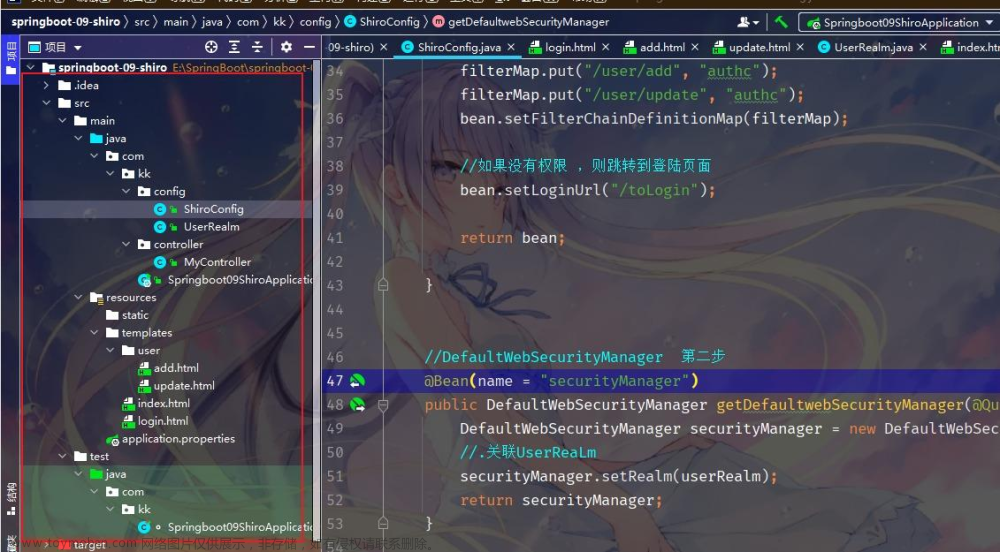
package com.kk.config;
import org.apache.shiro.authc.AuthenticationException;
import org.apache.shiro.authc.AuthenticationInfo;
import org.apache.shiro.authc.AuthenticationToken;
import org.apache.shiro.authz.AuthorizationInfo;
import org.apache.shiro.realm.AuthorizingRealm;
import org.apache.shiro.subject.PrincipalCollection;
//自定义的 UserRealm extends AuthorizingRealm
public class UserRealm extends AuthorizingRealm {
//授权
@Override
protected AuthorizationInfo doGetAuthorizationInfo(PrincipalCollection principalCollection) {
System.out.println(“执行科=》授权doGetAuthorizationInfo”);
return null;
}
//认证
@Override
protected AuthenticationInfo doGetAuthenticationInfo(AuthenticationToken authenticationToken) throws AuthenticationException {
System.out.println(“执行科=》认证doGetAuthenticationInfo”);
return null;
}
}
ShiroConfig
package com.kk.config;
import org.apache.shiro.mgt.DefaultSecurityManager;
import org.apache.shiro.spring.web.ShiroFilterFactoryBean;
import org.apache.shiro.web.mgt.DefaultWebSecurityManager;
import org.springframework.beans.factory.annotation.Qualifier;
import org.springframework.context.annotation.Bean;
import org.springframework.context.annotation.Configuration;
import java.util.HashMap;
import java.util.LinkedHashMap;
import java.util.Map;
@Configuration
public class ShiroConfig {
//ShiroFilterFactortBean 第三步
@Bean
public ShiroFilterFactoryBean getShiroFilterFactoryBean(@Qualifier(“securityManager”) DefaultWebSecurityManager defaultWebSecurityManager) {
ShiroFilterFactoryBean bean = new ShiroFilterFactoryBean();
//设置安全管理器
bean.setSecurityManager(defaultWebSecurityManager);
return bean;
}
//DefaultWebSecurityManager 第二步
@Bean(name = “securityManager”)
public DefaultWebSecurityManager getDefaultwebSecurityManager(@Qualifier(“userRealm”) UserRealm userRealm) {
DefaultWebSecurityManager securityManager = new DefaultWebSecurityManager();
//.关联UserReaLm
securityManager.setRealm(userRealm);
return securityManager;
}
//创建 realm 对象 需要自定义 第一步
@Bean
public UserRealm userRealm() {
return new UserRealm();
}
}
MyController
package com.kk.controller;
import org.springframework.jmx.export.annotation.ManagedResource;
import org.springframework.stereotype.Controller;
import org.springframework.ui.Model;
import org.springframework.web.bind.annotation.RequestMapping;
@Controller
public class MyController {
@RequestMapping({“/”,“/index”})
public String ToIndex(Model model){
model.addAttribute(“msg”,“hello Shiro”);
return “index”;
}
@RequestMapping(“/user/add”)
public String add(){
return “user/add”;
}
@RequestMapping(“/user/update”)
public String update(){
return “user/update”;
}
@RequestMapping(“/toLogin”)
public String toLogin(){
return “login”;
}
}
index.html
首页
add
update
add.html
add
update.html
update
7、shiro实现登录拦截
package com.kk.config;
import org.apache.shiro.mgt.DefaultSecurityManager;
import org.apache.shiro.spring.web.ShiroFilterFactoryBean;
import org.apache.shiro.web.mgt.DefaultWebSecurityManager;
import org.springframework.beans.factory.annotation.Qualifier;
import org.springframework.context.annotation.Bean;
import org.springframework.context.annotation.Configuration;
import java.util.HashMap;
import java.util.LinkedHashMap;
import java.util.Map;
@Configuration
public class ShiroConfig {
//ShiroFilterFactortBean 第三步
@Bean
public ShiroFilterFactoryBean getShiroFilterFactoryBean(@Qualifier(“securityManager”) DefaultWebSecurityManager defaultWebSecurityManager) {
ShiroFilterFactoryBean bean = new ShiroFilterFactoryBean();
//设置安全管理器
bean.setSecurityManager(defaultWebSecurityManager);
//添加shiro的内置过滤器
/*
anon : 无需认证就可以访问
authc:必须认证才能访问
user:必须拥有 记住我 功能才能用
perms 拥有某个资源的权限才能访问
role 拥有某个角色的权限才能访问
*/
Map<String, String> filterMap = new LinkedHashMap<>();
filterMap.put(“/user/add”, “authc”);
filterMap.put(“/user/update”, “authc”);
bean.setFilterChainDefinitionMap(filterMap);
//如果没有权限 ,则跳转到登陆页面
bean.setLoginUrl(“/toLogin”);
return bean;
}
//DefaultWebSecurityManager 第二步
@Bean(name = “securityManager”)
public DefaultWebSecurityManager getDefaultwebSecurityManager(@Qualifier(“userRealm”) UserRealm userRealm) {
DefaultWebSecurityManager securityManager = new DefaultWebSecurityManager();
//.关联UserReaLm
securityManager.setRealm(userRealm);
return securityManager;
}
//创建 realm 对象 需要自定义 第一步
@Bean
public UserRealm userRealm() {
return new UserRealm();
}
}
login.html
登陆
用户名:
密码:
MyController
@RequestMapping(“/toLogin”)
public String toLogin(){
return “login”;
}
8、Shiro实现用户认证
MyController
@RequestMapping(“/login”)
public String login(String username,String password,Model model){
//获取当前的用户
Subject subject = SecurityUtils.getSubject();
//封装登陆用户的登陆数据
UsernamePasswordToken token = new UsernamePasswordToken(username, password);
try{
subject.login(token);//执行登陆方法,如果没有异常就说明ok
return “index”;
}catch (UnknownAccountException e){//用户名不存在
model.addAttribute(“msg”,“用户名错误”);
return “login”;
}catch (IncorrectCredentialsException e){//密码不存在
model.addAttribute(“msg”,“密码错误”);
return “login”;
}
}
login.html
登陆
用户名:
密码:
UserRealm
//认证
@Override
protected AuthenticationInfo doGetAuthenticationInfo(AuthenticationToken token) throws AuthenticationException {
System.out.println(“执行了=》认证doGetAuthenticationInfo”);
//用户名 密码 —数据库
String name=“root”;
String password=“123456”;
UsernamePasswordToken userToken = (UsernamePasswordToken) token;
if (!userToken.getUsername().equals(name)){
return null;//抛出异常UnknownAccountException
}
//密码认证 shiro
return new SimpleAuthenticationInfo(“”,password,“”);
}
9、Shiro整合Mybatis
导入依赖
mysql
mysql-connector-java
log4j
log4j
1.2.17
com.alibaba
druid
1.2.6
org.mybatis.spring.boot
mybatis-spring-boot-starter
2.2.0
2.连接数据库application.yml
spring:
datasource:
username: root
password: 981204
#?serverTimezone=UTC解决时区的报错
url: jdbc:mysql://localhost:3306/mybatis?serverTimezone=UTC&useUnicode=true&characterEncoding=utf-8
driver-class-name: com.mysql.jdbc.Driver
type: com.alibaba.druid.pool.DruidDataSource
#Spring Boot 默认是不注入这些属性值的,需要自己绑定
#druid 数据源专有配置
initialSize: 5
minIdle: 5
maxActive: 20
maxWait: 60000
timeBetweenEvictionRunsMillis: 60000
minEvictableIdleTimeMillis: 300000
validationQuery: SELECT 1 FROM DUAL
testWhileIdle: true
testOnBorrow: false
testOnReturn: false
poolPreparedStatements: true
#配置监控统计拦截的filters,stat:监控统计、log4j:日志记录、wall:防御sql注入
#如果允许时报错 java.lang.ClassNotFoundException: org.apache.log4j.Priority
#则导入 log4j 依赖即可,Maven 地址: https://mvnrepository.com/artifact/log4j/log4j
filters: stat,wall,log4j
maxPoolPreparedStatementPerConnectionSize: 20
useGlobalDataSourceStat: true
connectionProperties: druid.stat.mergeSql=true;druid.stat.slowSqlMillis=500
3.设置application.properties
整合mybatis
mybatis.type-aliases-package=com.kk.pojo
mybatis.mapper-locations=classpath:mapper/*.xml
4.实体类
package com.kk.pojo;
public class User {
private int id;
private String name;
private String pwd;
public User() {
}
public User(int id, String name, String pwd) {
this.id = id;
this.name = name;
this.pwd = pwd;
}
public int getId() {
return id;
}
public void setId(int id) {
this.id = id;
}
public String getName() {
return name;
}
public void setName(String name) {
this.name = name;
}
public String getPwd() {
return pwd;
}
public void setPwd(String pwd) {
this.pwd = pwd;
}
@Override
public String toString() {
return “User{” +
“id=” + id +
“, name='” + name + ‘’’ +
“, pwd='” + pwd + ‘’’ +
‘}’;
}
}
5.UserMapper
package com.kk.mapper;
import org.apache.ibatis.annotations.Mapper;
import org.springframework.stereotype.Repository;
@Repository
@Mapper
public class UserMapper {
public User queryUserByName(String name);
}
6.UserMapper.xml
<?xml version="1.0" encoding="UTF-8" ?>select * from mybatis.user where name = #{name}
7.UserService
public interface UserService {
public User queryUserByName(String name);
}
8.UserServiceImpl
package com.kk.service;
import org.springframework.stereotype.Service;
@Service
public class UserServiceImp implements UserService{
@Autowired
UserMapper userMapper;
@Override
public User queryUserByName(String name) {
return userMapper.queryUserByName(name);
}
}
9.测试查出对应User
@SpringBootTest
class ShiroSpringbootApplicationTests {
@Autowired
UserServiceImpl userService;
@Test
void contextLoads() {
System.out.println(userService.queryUserByName(“雏田”));
}
}
10、测试成功后 将数据绑定到安全配置中,再次启动配置
package com.kk.config;
import com.kk.pojo.User;
import com.kk.service.UserService;
import org.apache.shiro.SecurityUtils;
import org.apache.shiro.authc.*;
import org.apache.shiro.authz.AuthorizationInfo;
import org.apache.shiro.realm.AuthorizingRealm;
import org.apache.shiro.subject.PrincipalCollection;
import org.apache.shiro.subject.Subject;
import org.springframework.beans.factory.annotation.Autowired;
//自定义的 UserRealm extends AuthorizingRealm
public class UserRealm extends AuthorizingRealm {
@Autowired
UserService userService;
//授权
@Override
protected AuthorizationInfo doGetAuthorizationInfo(PrincipalCollection principalCollection) {
System.out.println(“执行了=》授权doGetAuthorizationInfo”);
return null;
}
//认证
@Override
protected AuthenticationInfo doGetAuthenticationInfo(AuthenticationToken token) throws AuthenticationException {
System.out.println(“执行了=》认证doGetAuthenticationInfo”);
UsernamePasswordToken userToken = (UsernamePasswordToken) token;
//连接真实数据库
User user = userService.queryUserByName(userToken.getUsername());
if (user==null){ //没有这个用户
return null; //抛出异常UnknownAccountException
}
//密码认证 shiro
//可以加密 MD5加密 MD5盐值加密
return new SimpleAuthenticationInfo(“”,user.getPwd(),“”);
}
}
10、Shiro请求授权实现
1、授权正常的情况下,没有授权会跳转到未授权页面
package com.kk.config;
import org.apache.shiro.spring.web.ShiroFilterFactoryBean;
import org.apache.shiro.web.mgt.DefaultWebSecurityManager;
import org.springframework.beans.factory.annotation.Qualifier;
import org.springframework.context.annotation.Bean;
import org.springframework.context.annotation.Configuration;
import java.util.LinkedHashMap;
import java.util.Map;
@Configuration
public class ShiroConfig {
//ShiroFilterFactoryBean:3
@Bean
public ShiroFilterFactoryBean getShiroFilterFactoryBean(@Qualifier(“securityManager”) DefaultWebSecurityManager defaultWebSecurityManager) {
ShiroFilterFactoryBean bean = new ShiroFilterFactoryBean();
//设置安全管理器
bean.setSecurityManager(defaultWebSecurityManager);
/*anon:无需认 证就可以访问
authc:必须认证了 才能让问
user:.必须拥有 记住我功能才能用
perms:
拥有对某个资源的权限才能访间:
role:拥有某 个角色权限才能访问
*/
Map<String, String> filterMap = new LinkedHashMap<>();
//授权,正常的情况下,没有授权会跳转到未授权页面
filterMap.put(“/user/add”, “perms[user:add]”);
filterMap.put(“/user/update”, “perms[user:update]”);
//第二个为权限,只有persm=user:add/user:update] 才可能进入相应的页面
filterMap.put(“/user/*”, “authc”);
//filterMap.put(“/user/add”, “authc”);
//filterMap.put(“/user/update”, “authc”);
bean.setFilterChainDefinitionMap(filterMap);
//设置获录的请求
bean.setLoginUrl(“/toLogin”);
//未授权页面
bean. setUnauthorizedUrl(“/noauth”);
return bean;
}
//Dafaul tWebSecurityManager:2
@Bean(name = “securityManager”)
public DefaultWebSecurityManager getDefaultwebSecurityManager(@Qualifier(“userRealm”) UserRealm userRealm) {
自我介绍一下,小编13年上海交大毕业,曾经在小公司待过,也去过华为、OPPO等大厂,18年进入阿里一直到现在。
深知大多数Java工程师,想要提升技能,往往是自己摸索成长或者是报班学习,但对于培训机构动则几千的学费,着实压力不小。自己不成体系的自学效果低效又漫长,而且极易碰到天花板技术停滞不前!
因此收集整理了一份《2024年Java开发全套学习资料》,初衷也很简单,就是希望能够帮助到想自学提升又不知道该从何学起的朋友,同时减轻大家的负担。

既有适合小白学习的零基础资料,也有适合3年以上经验的小伙伴深入学习提升的进阶课程,基本涵盖了95%以上Java开发知识点,真正体系化!
由于文件比较大,这里只是将部分目录截图出来,每个节点里面都包含大厂面经、学习笔记、源码讲义、实战项目、讲解视频,并且会持续更新!
如果你觉得这些内容对你有帮助,可以扫码获取!!(备注Java获取)

最后
分布式技术专题+面试解析+相关的手写和学习的笔记pdf
还有更多Java笔记分享如下:
《互联网大厂面试真题解析、进阶开发核心学习笔记、全套讲解视频、实战项目源码讲义》点击传送门即可获取!
tWebSecurityManager) {
ShiroFilterFactoryBean bean = new ShiroFilterFactoryBean();
//设置安全管理器
bean.setSecurityManager(defaultWebSecurityManager);
/*anon:无需认 证就可以访问
authc:必须认证了 才能让问
user:.必须拥有 记住我功能才能用
perms:
拥有对某个资源的权限才能访间:
role:拥有某 个角色权限才能访问
*/
Map<String, String> filterMap = new LinkedHashMap<>();
//授权,正常的情况下,没有授权会跳转到未授权页面
filterMap.put(“/user/add”, “perms[user:add]”);
filterMap.put(“/user/update”, “perms[user:update]”);
//第二个为权限,只有persm=user:add/user:update] 才可能进入相应的页面
filterMap.put(“/user/*”, “authc”);
//filterMap.put(“/user/add”, “authc”);
//filterMap.put(“/user/update”, “authc”);
bean.setFilterChainDefinitionMap(filterMap);
//设置获录的请求
bean.setLoginUrl(“/toLogin”);
//未授权页面
bean. setUnauthorizedUrl(“/noauth”);
return bean;
}
//Dafaul tWebSecurityManager:2
@Bean(name = “securityManager”)
public DefaultWebSecurityManager getDefaultwebSecurityManager(@Qualifier(“userRealm”) UserRealm userRealm) {
自我介绍一下,小编13年上海交大毕业,曾经在小公司待过,也去过华为、OPPO等大厂,18年进入阿里一直到现在。
深知大多数Java工程师,想要提升技能,往往是自己摸索成长或者是报班学习,但对于培训机构动则几千的学费,着实压力不小。自己不成体系的自学效果低效又漫长,而且极易碰到天花板技术停滞不前!
因此收集整理了一份《2024年Java开发全套学习资料》,初衷也很简单,就是希望能够帮助到想自学提升又不知道该从何学起的朋友,同时减轻大家的负担。[外链图片转存中…(img-VobvgnQs-1713053765311)]
[外链图片转存中…(img-xkslkYbr-1713053765311)]
[外链图片转存中…(img-UB15EeDP-1713053765312)]
既有适合小白学习的零基础资料,也有适合3年以上经验的小伙伴深入学习提升的进阶课程,基本涵盖了95%以上Java开发知识点,真正体系化!
由于文件比较大,这里只是将部分目录截图出来,每个节点里面都包含大厂面经、学习笔记、源码讲义、实战项目、讲解视频,并且会持续更新!
如果你觉得这些内容对你有帮助,可以扫码获取!!(备注Java获取)

最后
分布式技术专题+面试解析+相关的手写和学习的笔记pdf
还有更多Java笔记分享如下:
[外链图片转存中…(img-PYoCgCea-1713053765312)]文章来源:https://www.toymoban.com/news/detail-855006.html
《互联网大厂面试真题解析、进阶开发核心学习笔记、全套讲解视频、实战项目源码讲义》点击传送门即可获取!文章来源地址https://www.toymoban.com/news/detail-855006.html
到了这里,关于3万字《SpringBoot微服务开发——Shiro(安全)》的文章就介绍完了。如果您还想了解更多内容,请在右上角搜索TOY模板网以前的文章或继续浏览下面的相关文章,希望大家以后多多支持TOY模板网!


